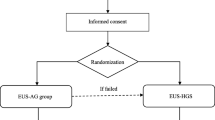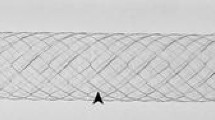Abstract
Background and Aims
Endoscopic ultrasound (EUS)-guided hepaticogastrostomy (HGS) may be a feasible and useful alternative in patients with malignant biliary obstruction (MBO) after failed endoscopic retrograde cholangiopancreatography (ERCP). To date, the risk factors for adverse events (AEs) and long-term outcomes of EUS-HGS have not been fully explored according to stent type. Therefore, we evaluated potential risk factors for AEs and long-term outcomes of EUS-HGS.
Methods
In total, 120 patients who underwent EUS-HGS were retrospectively reviewed. A multivariate analysis through Cox proportional hazard and logistic regression model was used to identify the risk factors for stent dysfunction and AEs, respectively. Stent patency and patient survival were evaluated using Kaplan–Meier plots with a log-rank test for each stent.
Results
The technical and clinical success rates were 96.2% (102/106) and 83.0% (88/106). The median duration of stent patency was longer in self-expandable metal stents (SEMS) compared to plastic stents (PS) (158 vs. 108 days). Kaplan–Meier analysis indicated that the type of stent was not associated with stent patency (Hazard ratios [HR] 0.997, 95% confidence interval [CI] [0.525–1.896]) or overall survival. In addition, multivariate analysis indicated that hilar MBO significantly associated with stent dysfunction (HR, 2.340; 95% CI, 1.028–5.326, p = 0.043) and late AEs.
Conclusions
Given the lower incidence of AEs and better long-term outcomes of EUS-HGS, it can be considered a safe alternative to ERCP or percutaneous approaches regardless of which stent is used. Furthermore, hilar MBO was established as a potential risk factor for stent dysfunction and late AEs.


Similar content being viewed by others
References
Giovannini M, Moutardier V, Pesenti C et al (2001) Endoscopic ultrasound-guided bilioduodenal anastomosis: a new technique for biliary drainage. Endoscopy 33:898–900
Fogel EL, McHenry L, Sherman S et al (2005) Therapeutic biliary endoscopy. Endoscopy 37:139–145
Bailey AA, Bourke MJ, Williams SJ et al (2008) A prospective randomized trial of cannulation technique in ERCP: effects on technical success and post-ERCP pancreatitis. Endoscopy 40:296–301
Kawakubo K, Isayama H, Kato H et al (2014) Multicenter retrospective study of endoscopic ultrasound-guided biliary drainage for malignant biliary obstruction in Japan. J Hepatobiliary Pancreat Sci 21:328–334
Park DH, Jeong SU, Lee BU et al (2013) Prospective evaluation of a treatment algorithm with enhanced guidewire manipulation protocol for EUS-guided biliary drainage after failed ERCP (with video). Gastrointest Endosc 78:91–101
Park DH, Jang JW, Lee SS et al (2011) EUS-guided biliary drainage with transluminal stenting after failed ERCP: predictors of adverse events and long-term results. Gastrointest Endosc 74:1276–1284
Song TJ, Lee SS, Park DH et al (2014) Preliminary report on a new hybrid metal stent for EUS-guided biliary drainage (with videos). Gastrointest Endosc 80:707–711
Cho DH, Lee SS, Oh D et al (2017) Long-term outcomes of a newly developed hybrid metal stent for EUS-guided biliary drainage (with videos). Gastrointest Endosc 85:1067–1075
Hamada T, Nakai Y, Isayama H et al (2013) Trimming a covered metal stent during hepaticogastrostomy by using argon plasma coagulation. Gastrointest Endosc 78:817
Umeda J, Itoi T, Tsuchiya T et al (2015) A newly designed plastic stent for EUS-guided hepaticogastrostomy: a prospective preliminary feasibility study (with videos). Gastrointest Endosc 82(390–396):e2
Ogura T, Masuda D, Imoto A et al (2014) EUS-guided hepaticogastrostomy combined with fine-gauge antegrade stenting: a pilot study. Endoscopy 46:416–421
Yamamoto K, Itoi T, Tsuchiya T et al (2018) EUS-guided antegrade metal stenting with hepaticoenterostomy using a dedicated plastic stent with a review of the literature (with video). Endosc Ultrasound 7:404–412
Paik WH, Lee TH, Park DH et al (2018) EUS-Guided Biliary Drainage Versus ERCP for the Primary Palliation of Malignant Biliary Obstruction: A Multicenter Randomized Clinical Trial. Am J Gastroenterol 113:987–997
Minaga K, Ogura T, Shiomi H et al (2019) Comparison of the efficacy and safety of endoscopic ultrasound-guided choledochoduodenostomy and hepaticogastrostomy for malignant distal biliary obstruction: Multicenter, randomized, clinical trial. Dig Endosc 31:575–582
Park CH, Park SW, Hyun B et al (2018) Efficacy and safety of etomidate-based sedation compared with propofol-based sedation during ERCP in low-risk patients: a double-blind, randomized, noninferiority trial. Gastrointest Endosc 87:174–184
Leung Ki EL, Napoleon B (2019) EUS-specific stents: Available designs and probable lacunae. Endosc Ultrasound 8:S17–S27
De Cassan C, Bories E, Pesenti C et al (2017) Use of partially covered and uncovered metallic prosthesis for endoscopic ultrasound-guided hepaticogastrostomy: Results of a retrospective monocentric study. Endosc Ultrasound 6:329–335
Sharaiha RZ, Khan MA, Kamal F et al (2017) Efficacy and safety of EUS-guided biliary drainage in comparison with percutaneous biliary drainage when ERCP fails: a systematic review and meta-analysis. Gastrointest Endosc 85:904–914
Kongkam P, Tasneem AA, Rerknimitr R (2019) Combination of endoscopic retrograde cholangiopancreatography and endoscopic ultrasonography-guided biliary drainage in malignant hilar biliary obstruction. Dig Endosc 31(Suppl 1):50–54
Moryoussef F, Sportes A, Leblanc S et al (2017) Is EUS-guided drainage a suitable alternative technique in case of proximal biliary obstruction? Therap Adv Gastroenterol 10:537–544
Minaga K, Takenaka M, Kitano M et al (2017) Rescue EUS-guided intrahepatic biliary drainage for malignant hilar biliary stricture after failed transpapillary re-intervention. Surg Endosc 31:4764–4772
Park DH (2012) Endoscopic ultrasonography-guided hepaticogastrostomy. Gastrointest Endosc Clin N Am 22(271–80):ix
Bories E, Pesenti C, Caillol F et al (2007) Transgastric endoscopic ultrasonography-guided biliary drainage: results of a pilot study. Endoscopy 39:287–291
Khashab MA, Valeshabad AK, Modayil R et al (2013) EUS-guided biliary drainage by using a standardized approach for malignant biliary obstruction: rendezvous versus direct transluminal techniques (with videos). Gastrointest Endosc 78:734–741
Park DH (2015) Endoscopic ultrasound-guided biliary drainage of hilar biliary obstruction. J Hepatobiliary Pancreat Sci 22:664–668
Nakai Y, Isayama H, Yamamoto N et al (2016) Safety and effectiveness of a long, partially covered metal stent for endoscopic ultrasound-guided hepaticogastrostomy in patients with malignant biliary obstruction. Endoscopy 48:1125–1128
Martins FP, Rossini LG, Ferrari AP (2010) Migration of a covered metallic stent following endoscopic ultrasound-guided hepaticogastrostomy: fatal complication. Endoscopy 42(Suppl 2):E126–E127
Funding
None.
Author information
Authors and Affiliations
Contributions
Conception and design: JHC, SSL, and SWP; Data analysis and interpretation: JHC, SSL, EJK, SWP, DHP, KJL, and CHP; Article drafting: JHC, SSL, and SWP; Critical revision of the article for important intellectual content: JHC, SSL, and SWP; Final approval of the article: JHC, SSL, and SWP.
Corresponding authors
Ethics declarations
Disclosures
Jae Hee Cho, Sang Soo Lee, Eui Joo Kim, Da Hae Park, Chan Hyuk Park, Kyong Joo Lee, and Se Woo Park have no conflicts of interest to disclose.
Additional information
Publisher's Note
Springer Nature remains neutral with regard to jurisdictional claims in published maps and institutional affiliations.
Supplementary Information
Below is the link to the electronic supplementary material.
Rights and permissions
About this article
Cite this article
Cho, J.H., Park, S.W., Kim, E.J. et al. Long-term outcomes and predictors of adverse events of EUS-guided hepatico-gastrostomy for malignant biliary obstruction: Multicenter, retrospective study. Surg Endosc 36, 8950–8958 (2022). https://doi.org/10.1007/s00464-022-09346-z
Received:
Accepted:
Published:
Issue Date:
DOI: https://doi.org/10.1007/s00464-022-09346-z




